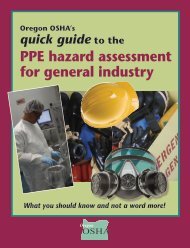Technical Manual - Section 3 (Safety Hazards)
Technical Manual - Section 3 (Safety Hazards)
Technical Manual - Section 3 (Safety Hazards)
Create successful ePaper yourself
Turn your PDF publications into a flip-book with our unique Google optimized e-Paper software.
phenols, ammonia, sulfides, and other compounds.<br />
Wastewater includes condensed steam, stripping water, spent<br />
caustic solutions, cooling tower and boiler blowdown, wash<br />
water, alkaline and acid waste neutralization water, and other<br />
process-associated water.<br />
PRETREATMENT OPERATIONS<br />
Pretreatment is the separation of hydrocarbons and solids<br />
from wastewater. API separators, interceptor plates, and<br />
settling ponds remove suspended hydrocarbons, oily sludge,<br />
and solids by gravity separation, skimming, and filtration.<br />
Some oil-in-water emulsions must be heated first to assist in<br />
separating the oil and the water. Gravity separation depends<br />
on the specific gravity differences between water and<br />
immiscible oil globules, which allows free oil to be skimmed<br />
off the surface of the wastewater. Acidic wastewater is<br />
neutralized using ammonia, lime, or soda ash. Alkaline<br />
wastewater is treated with sulfuric acid, hydrochloric acid,<br />
carbon dioxide-rich flue gas, or sulfur.<br />
SECONDARY TREATMENT OPERATIONS<br />
After pretreatment, suspended solids are removed by<br />
sedimentation or air flotation. Wastewater with low levels of<br />
solids may be screened or filtered. Flocculation agents are<br />
sometimes added to help separation. Secondary treatment<br />
processes biologically degrade and oxidize soluble organic<br />
matter by the use of activated sludge, unaerated or aerated<br />
lagoons, trickling filter methods, or anaerobic treatments.<br />
Materials with high adsorption characteristics are used in<br />
fixed-bed filters or added to the wastewater to form a slurry<br />
which is removed by sedimentation or filtration. Additional<br />
treatment methods are used to remove oils and chemicals<br />
from wastewater. Stripping is used on wastewater containing<br />
sulfides and/or ammonia, and solvent extraction is used to<br />
remove phenols.<br />
activated carbon adsorption, etc. Compressed oxygen is<br />
diffused into wastewater streams to oxidize certain chemicals<br />
or to satisfy regulatory oxygen-content requirements.<br />
Wastewater that is to be recycled may require cooling to<br />
remove heat and/or oxidation by spraying or air stripping to<br />
remove any remaining phenols, nitrates, and ammonia.<br />
HEALTH AND SAFETY CONSIDERATIONS<br />
Fire Protection and Prevention<br />
The potential for fire exists if vapors from wastewater<br />
containing hydrocarbons reach a source of ignition during<br />
treatment.<br />
Health<br />
Safe work practices and/or appropriate personal protective<br />
equipment may be needed for exposures to chemicals and<br />
waste products during process sampling, inspection,<br />
maintenance, and turnaround activities as well as to noise,<br />
gases, and heat.<br />
COOLING TOWERS<br />
Cooling towers remove heat from process water by<br />
evaporation and latent heat transfer between hot water and<br />
air. The two types of towers are crossflow and counterflow.<br />
Crossflow towers introduce the airflow at right angles to the<br />
water flow throughout the structure. In counterflow cooling<br />
towers, hot process water is pumped to the uppermost plenum<br />
and allowed to fall through the tower. Numerous slats or<br />
spray nozzles located throughout the length of the tower<br />
disperse the water and help in cooling. Air enters at the tower<br />
bottom and flows upward against the water. When the fans or<br />
blowers are at the air inlet, the air is considered to be forced<br />
draft. Induced draft is when the fans are at the air outlet.<br />
TERTIARY TREATMENT OPERATIONS<br />
Tertiary treatments remove specific pollutants to meet<br />
regulatory discharge requirements. These treatments include<br />
chlorination, ozonation, ion exchange, reverse osmosis,<br />
III:2-53
















